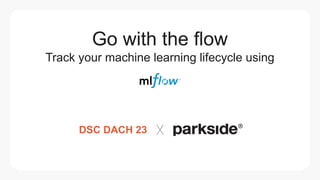[DSC DACH 23] Go with the flow – Track your machine learning lifecycle using MLflow - Philipp Danninger
- 1. DSC DACH 23 ╳ Go with the flow Track your machine learning lifecycle using
- 2. Agenda 1. Introduction to Parkside Interactive 2. Why track your ML lifecycle? 3. What is MLflow? 4. Tutorial 5. Recap
- 3. We Work Globally and Have Offices in GrazHQ , Linz, Vienna, Porto & San Francisco. PORTO GRAZHQ VIENNA LINZ SAN FRANCISCO
- 4. Software Development Frontend Development / Mobile Development / Backend & API Development / Platform Development Research & Testing User Research & Testing / Usability Testing / Expert Reviews / UX Strategy & Measurement / Market & Product Research Design & Tech Consulting Product Thinking / Proof of Concept / Product & Business Analysis / Requirements Engineering / Discovery Workshops Agile Methodologies Scrum / Kanban / SAFe / LESS / Agile Contracting Product Development Product Management & Ownership / Custom Software Development / UX Design / Proof of Concept & Prototyping / MVP Software- & System-Architecture Microservices / Cloud Native Technologies / Scalability / Database Schema / Containerization / Client Architecture Support, Maintenance & Optimization A/B Testing / Performance Analysis / Conversion Optimization / Release Management / SLA User Experience & Design Accessibility & Inclusive Design / UX Writing / Information Architecture / User Interface Design / Design Systems / Digital Branding 01 02 03 05 06 07 09 10 Quality Assurance & Testing Strategy / Management / Automation / Execution DevOps Cloud Native / Continuous Integration / Continuous Deployment / Continuous Delivery 04 08 Parkside offers customized services across the entire digital product lifecycle. 12 Data Science & AI Use-Case Identification Data Analysis and POC phase ML model development and validation Bringing models into production 13 Cyber Security White Box Audits / Secure Software Development Lifecycle / Threat Modelling / SAST / SCA 4
- 5. DATA SCIENTIST Philipp Danninger Based in Graz, Austria MSc in Economics MSc in Data & Information Science danninger@parkside-interactive.com www.linkedin.com/in/philipp-danninger
- 6. Why track the lifecycle of ML applications? What are ingress channels? How often do you receive new data? Data ingress Deployment method & workflow? What is the final model’s version? Dependencies? Model deployment & maintenance Data imputations? Sample sizes? Split size? Data leakage? Training set creation Choice of algorithm? Hyperparameters? Cross-validation? Performance metrics? Model training & evaluation What parts of the data are usable? How to store the data? Data cleaning Can you answer all the questions after some time has passed? Store all components for reproducibility in one place → MLflow
- 7. What is MLflow? ● Open source platform for machine learning lifecycle ● 4 components ○ MLflow Tracking ○ MLflow Projects ○ MLflow Models ○ MLflow Registry
- 8. Some MLflow Tracking basics ● MLflow Tracking is organized around the concept of runs, which are executions of some piece of data science code ● You can optionally organize runs into experiments, which group together runs for a specific task ● Code version (git commit), start & end time, source, parameters, metrics, artifacts ● Store runs locally, to SQLAlchemy compatible database or remote tracking server ● Once your runs have been recorded, you can query them using the Tracking UI or the MLflow API
- 9. Tutorial - What are we going to cover? ML problem: Prediction of California house prices Creation of ML pipeline MLflow: ● Experiments - different algorithms ● MLflow runs for experiments ● Tracking of artifacts, performance metrics & hyperparameters ● Registration of models ● Prediction using registered models Repo: https://github.com/pdanninger/dsc_dach.git
- 10. Recap ● Machine learning use-cases pose individual challenges ● A transparent documentation of your approach saves a lot of time ● MLflow provides simple but powerful capabilities to document and structure your approach for reproducibility ● MLflow allows you to structure the deployment of your machine learning models

